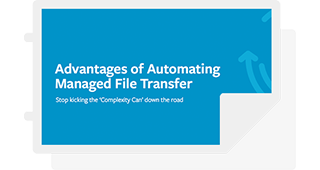Do you know that typical enterprises transfer thousands of files every single day? It’s no secret that managed file transfers are essential to business operations and the systems that depend upon them. In fact, BMC research indicates file transfers represent about one out of every five jobs scheduled through workload automation solutions.
Data files keep getting larger, and the data used by enterprises is being shared by more systems and partners than ever before. To put this growth into perspective, according to Forbes, the accumulated digital universe of data will grow to approximately 44 trillion gigabytes by 2020, up from 4 trillion in 2015.
Digital business is a key driver in the explosive growth of data. That’s why organizations must be better prepared to manage file transfers faster and more frequently to keep up with the workloads and applications they support. Yet, relying on multiple tools and specialists to manage file transfers and other related workloads is risky and can jeopardize a company’s ability to respond quickly to business requirements.
Consider these situations:
- If a critical payroll file transfer doesn’t happen on time because you lack the visibility to see what’s causing a problem with the transfer, people may not get paid on time.
- Retailers regularly send pricing update files to stores. If a file transfer doesn’t happen on time, revenue could drop.
- If regulation changes impact your industry and you can’t transfer files securely and accurately, compliance could be jeopardized.
Challenges with Managed File Transfers
Some enterprises use multiple file transfer solutions and separate workload automation solutions to manage their systems. When multiple systems are used, companies often struggle because they don’t have a clear understanding of when file transfers and processing will be complete, thus jeopardizing service levels. This lack of visibility makes it difficult to understand where problems occur and how to correct them, as multiple non-integrated solutions must be consulted.
As more interactions between systems happen, additional time-consuming scripting is required. Traditional file transfer solutions typically lack robust scheduling, security granularity, SLA monitoring, web and mobile interfaces, and automated, proactive notifications.
When transfers aren’t consolidated and automated, they’re likely to have problems that require more manual effort and expertise. In fact, according to Forrester, 67% of companies without an enterprise-wide job scheduler lack integrated and managed file transfers, which leads to errors and business issues.
Multiple solutions are inefficient
It’s important to manage scheduling information and workloads across all applications, including file transfers, from a single point of control. Without the ability to manage data that flows among applications, you can’t determine whether a file transfer has completed on time or if a transfer has failed.
Managing file transfers with multiple solutions doesn’t work because it:
- Requires inefficient scripting changes and manual integration
- Has high risks and costs with a greater likelihood an error will cause a transfer failure
- Limits your ability to execute transfers quickly, preventing you from maximizing digital initiatives
- Makes it difficult to monitor the overall file transfer status, which may result in delays and errors
Choosing a Managed File Transfer solution
File transfers and related application workflows should be tightly integrated with a powerful scheduling solution.
Here are six key requirements to consider:
- Uses a highly efficient file transfer management solution that has dynamic scheduling capabilities and that provides a single point of control
- Has a dashboard view of file transfer status and endpoint activity, which delivers instant visibility into all file transfer operations, including the status of transfers, throughput levels, and endpoint details
- Reduces complexity and improves staff productivity with a solution that doesn’t require scripting or extensive training to install and use in production
- Delivers advanced search capabilities that lets users easily find details of a specific file transfer, using any number of data points, including transfer status, source, destination host information, file name, and other values
- Provides secure file transfers by supporting protocols such as FTP, SFTP, FTPS, and PGP encryption
- Enables anyone in the organization to access what they need from their desktops or mobile devices
Get Control-M Managed File Transfer
Address these challenges and move from traditional workload automation to the next wave of IT automation—Digital Business Automation.
Control-M Managed File Transfer delivers Digital Business Automation and managed file transfers, giving you visibility into the status of transfers with a dashboard view, enhanced security with encryption options, and reduced risk of downtime with automated monitoring and recovery features. And you can securely automate file transfers from a central interface, integrating them with other applications and activities for greater convenience, visibility, and control. File transfers are searchable by many attributes (e.g., destination host, transfer type, file size, etc.) and the dashboard can easily be used by anyone in the organization, whether they are file transfer experts or not.
Unlike non-integrated products that exist in their own silos, Control-M Managed File Transfer delivers a combined solution that lowers risk and remediation cost in delivering business services. It eliminates the need to use different schedulers and file transfer systems, while enhancing security. Controls are in one place to make sure critical jobs are executed without disruption, increasing reliability by reducing errors that can cause file transfer failure. Plus, no scripting is required to integrate file transfers with related workload jobs, which reduces complexity and saves time. This user-friendly solution meets and surpasses the needs of a new generation of IT professionals.
Automate managed file transfer
These postings are my own and do not necessarily represent BMC's position, strategies, or opinion.
See an error or have a suggestion? Please let us know by emailing blogs@bmc.com.







